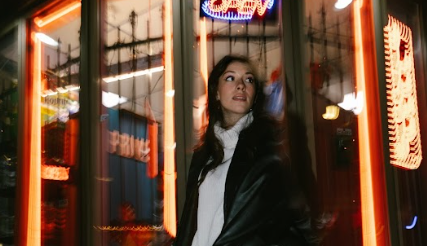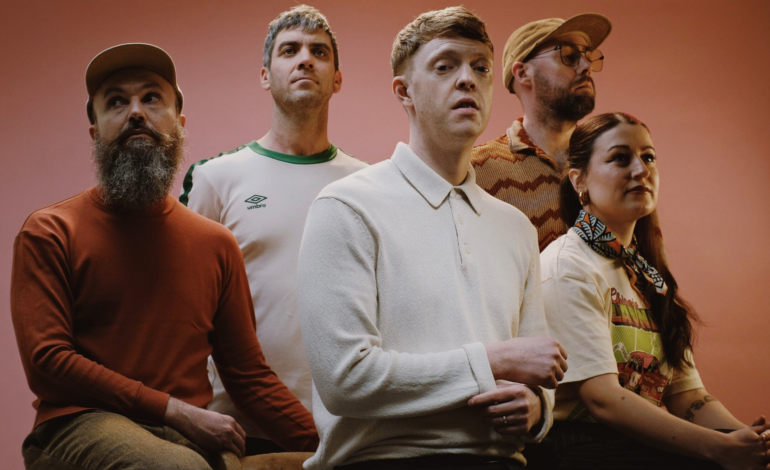Muscle Memory blends rock influences with electronic dance music. How did your respective experiences in indie rock bands shape your approach to this project?
Having spent our formative years in indie rock bands, specifically in the so-called “indie-sleaze” era of NYC indie, we developed an appreciation for making music that’s both fun & engaging, with a value for the unique & unexpected, but also firmly rooted in historical influences. Part of our process & practice of making music has always included understanding & researching different bands & musical scenes and digging for obscure tracks & records, not just to take sounds & ideas, but also to learn from the creative ethos of the artists. We’ve really enjoyed approaching this project in the same way, digging into dance music history, from the post-disco of Prelude Records to 80’s Italo Disco to Chicago House to early Detroit techno, New York garage, etc. There was so much amazing creativity & experimentation in these scenes, harnessing what was new technology at the time in synthesizers & drum machines to make inclusive dance music for such foundational spaces like Paradise Garage, etc. It’s such a rich world to immerse yourself in, and we’ve really enjoyed combining that stuff, both the sounds & ethos, with the more post-punk kind of element we inhabited in our indie days.
With a background in live performances, how do you balance the energy of live shows with the production techniques of electronic music?
Playing live is an important part of what we do, and even though a lot of our instrumentation is drum machines & synthesizers playing preset sequences & whatnot, we also incorporate live guitar & percussion elements and also have the synthesizers making the sounds onstage (receiving midi from the MPC brain, if you care for the specifics) rather than playing prerecorded backing tracks. So the whole thing has a live feel while also being locked into the dance grooves. The goal is to bring the feeling of the dance club into the live performance space.
What was the initial spark that led you both to form Muscle Memory, and how did your individual backgrounds influence the creation of the duo?
We had each been edging into the electronic music sphere with solo projects and had also each been getting more into DJing, and moving from the more vinyl listening bar style to the club dance floors. We started DJing together and finding a lot of commonality in the records we were playing and what we were exploring, and at some point we were like, “Hey, do you want to try making some music together that will fit into what we’re DJing on the dance floor?” And when we tried it, it really just clicked. Michael had been exploring synthesis for a few years, literally opening them up to repair them & figuring out how they work in the process. Steven had been coming at it from another direction, using Juno 60 & Roland drum machines in his songwriting practice, so it felt very natural to combine what we each were doing into this new project.
You’ve described ‘Get Lost’ as being inspired by what Fleetwood Mac could sound like if produced by Giorgio Moroder. Can you tell us more about that vision and how it shaped the track?
The Fleetwood Mac – Giorgio Moroder connection was sort of a realization we had after we made the song. Usually we make tracks together in the studio, and often Steven will write vocal parts after we have the basis of the track already put together. But for Get Lost, he wrote it on his own and recorded the vocal part over a simple bass line progression. When he brought it into the studio, we thought it had kind of a Fleetwood Mac vibe to it, and we were wondering how we could bring it into the world we’re trying to create, and if it was possible. While we were trying to determine a direction for it, we were inspired by some Italo Disco tracks we had been playing lately in our DJ sets, and we tried taking it in that direction and really liked where it was going. Afterward we were like, how did we get here from there? And we were like, I guess it’s kind of like if Fleetwood Mac had been produced by Giorgio Moroder, and actually, we really wish that would have happened. It probably would have been pretty cool, albeit much more coked up than what we did.
The track has a shimmering synthpop vibe. What was the process behind creating the sound and feel of ‘Get Lost,’ and how did you know it was the right direction for Muscle Memory?
Like everything we make, we try to imagine the sonic world we want it to live in, and the synthpop world of Italo Disco & New Wave music from the 80’s is definitely part of that world. But also, we like to work with just a few pieces of gear at a time in the studio, so we look around, and we say, ok what can this Juno do for us here, or let’s get something going on that 101 or whatever. Sometimes we kind of restrain our options to force ourselves to be creative within some constraints.
Your music seems to seamlessly combine nostalgic influences with a modern edge. What do you think it is about these styles that makes them so appealing, especially in the current music scene?
We like our music to be rooted in historical influences, praise be to the musical pioneers, but we also want it to sit well next to more modern music, because we play a very eclectic mix of music when we DJ – a lot of stuff from the 80’s and early 90’s but also modern tracks from artists like Decius & Paula Tape, to name just a couple artists we love right now. We don’t want our music to sound like one style in particular, like oh this is house music or this is disco or post-punk or whatever, but we want it to be more like going back to where modern dance music originated from and kind of combining elements of what different artists were doing in different scenes at the same time in various places in the world, and it was all being played in the same clubs like Paradise Garage or the Hacienda or the Warehouse, and we like to imagine we’re making something that could have been played at those places as well. But we also want it to hit hard on modern dance floors. We’re not trying to be a throwback group. We think all of that music is still relevant and really is the foundation of what modern dance music is built on.
How did the collaboration with Midnight Magic on the dub remix come about, and how do you feel their take complements the original track?
We’ve been fans of Midnight Magic for years and play Justin Strauss’s remix of their track Beam Me Up a lot in our DJ sets. When Justin Strauss was making his remix of our song Body Of Light, he was working in the studio of Midnight Magic’s bassist Andrew Raposo, and we really loved the sound and what they made. We asked Andrew if he’d mix some of our other tracks, and he’s been a joy to work with, so we asked if Midnight Magic might be down to do a remix for us, and we’re so psyched with what they made. We love when someone reimagines our work and takes some elements but comes up with something completely different, and they did something wonderful & totally unexpected. We think of our original as kind of an Italo Disco synthpop track, and they turned it into something spacey & hypnotic, turning the chorus into something like a mantra, and it really takes you on a journey. As it develops, it just makes us smile the whole time, and it’s really fun on the dance floor.
You’ve had success with previous releases like ‘Taste of a Kiss’ and ‘Body of Light.’ How does ‘Get Lost’ compare, and what are you most excited about for its release?
So far with each release, we think of the next song as introducing a different dimension to our sound and gradually building a whole sonic world full of beautiful textures and surprising complexities, and we consider the different versions on the release as part of that. For each song we put out, we include with the original a remix by another artist, which is the Midnight Magic remix for Get Lost, as well as our own Club Mix, which is basically us reimagining our own track specifically for the dance floor, in addition to an extended version. We model the releases after the 12” singles that were common in the 80’s and early 90’s made for DJ’s that we generally play at the club. For every song, there are usually 3 or 4 different versions, remixes, dub mixes, etc., and it’s really fun to find the ones that we think will hit best during our DJ’s sets or in various contexts, and we love the process of reimaging our songs in the same way.
Can you tell us a bit about the writing and recording process for the track? Was it more of a spontaneous creation, or was there a lot of meticulous planning?
For Get Lost, Steven wrote the vocal part on his own in a fit of inspiration. Literally he was like, “I can’t leave the house, I’m working on this song,” for like 2 or 3 days. When he brought it into the studio, there was some experimentation to figure out where we wanted to go with it production-wise. After a few false starts, we had the idea to try bringing it into the world of this Italo classic Walking In The Neon by Peter Richard that we had been spinning a lot in our DJ sets. They aren’t really in the same tempo range, but even just having that idea gave us sort of a blueprint for approaching the track, and things started falling into place.
How does your residency at Nightmoves influence your music-making and creative process, especially when it comes to blending DJing with live performance?
DJing at a dance club like Nightmoves is a very different beast than performing live as a band. It’s more about facilitating people’s experience on the dance floor, rather than creating an engaging sonic and visual spectacle for people to watch. At the club, we take a lot of cues from the dance floor that influences what records we play next, and where the night goes is sort of a joint effort created by all of us together, feeding off of each other. We often take certain moments or ways that different elements of songs play out in the club as inspiration for things we want to incorporate into our own songs or moments we’d like to have when we perform live, because we want to have something of a dance club type atmosphere at our live shows. So in some ways, our DJ residency at Nightmoves is sort of an incubator for the musical ideas we ultimately use in our songwriting and production process.


